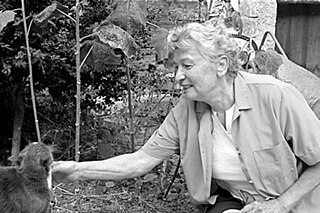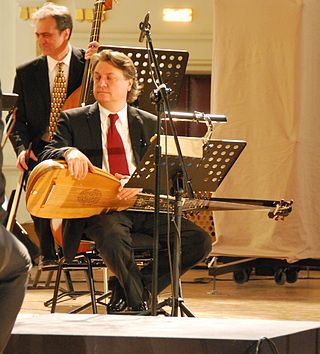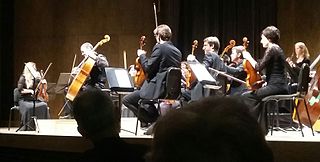Related Research Articles

The viola da gamba, or informally gamba, is any one of a family of bowed, fretted, and stringed instruments with hollow wooden bodies and pegboxes where the tension on the strings can be increased or decreased to adjust the pitch of each of the strings. Although treble, tenor and bass were most commonly used, viols came in different sizes, including pardessus, treble, alto, small tenor, tenor, bass and contrabass. Separating these from other bowed string instruments such as the viola da braccio was the instruments' orientation; members of the older viol family were played with the neck oriented upwards, the rounded bottom downwards to settle on the lap or between the knees.

Johann Nikolaus Harnoncourt was an Austrian conductor, known for his historically informed performances. He specialized in music of the Baroque period, but later extended his repertoire to include Classical and early Romantic works. Among his best known recordings are those of Bach, whose 193 cantatas he recorded with Gustav Leonhardt.

Marin Marais was a French composer and viol player. He studied composition with Jean-Baptiste Lully, often conducting his operas, and with master of the bass viol Monsieur de Sainte-Colombe for six months. In 1676 he was hired as a musician to the royal court of Versailles and was successful there, being appointed in 1679 as ordinaire de la chambre du roy pour la viole, a title he kept until 1725.

Hille Perl is a German virtuoso performer of the viola da gamba and lirone.

Éliane Radigue is a French electronic music composer. She began working in the 1950s and her first compositions were presented in the late 1960s. Until 2000 her work was almost exclusively created with the ARP 2500 modular synthesizer and tape. Since 2001 she has composed mainly for acoustic instruments.
Machy, known as Le Sieur de Machy was a French viol player, composer, and teacher remembered principally for his Pièces de Violle en Musique et en Tablature (1685), a valuable source of information on the performance practices of his time. "The publication of the Pièces de Violle (..) unleashed a veritable polemic or querelle with Jean Rousseau concerning the “true manner of playing the viol”, which had been described by Machy with a wealth of details in the prologue to his work (..)". As a reply to Machy's 1685 prologue, Rousseau in 1688 published Réponce de Monsieur Rousseau. This polemic and a general discussion of Machy was treated by Ng in 2008.
Sandrine Piau is a French soprano. She is particularly renowned in Baroque music although also excels in Romantic and modernist art songs. She has the versatility to perform works from Vivaldi, Handel, Mozart to Schumann, Debussy, and Poulenc. In addition to an active career in concerts and operas, she is prolific in studio recordings, primarily with Harmonia Mundi, Naïve, and Alpha since 2018.

Michael Edwards, later known as Swami Deva Pramada or simply Pramada, was an English cellist and music teacher. He was a member of the Electric Light Orchestra in its early years.
Lorenz Duftschmid is an Austrian viol player and conductor.

Luca Pianca is a Swiss musician-lutenist whose specialty is archlute. In 1985 he co - founded Il Giardino Armonico., a pioneering Italian early-music ensemble based in Milan. He has premiered works by the contemporary lutenist-composer Roman Turovsky-Savchuk at international festivals, and received numerous international awards for his recordings.

Vittorio Ghielmi is an Italian musician, conductor, composer. Compared by critics to Jasha Heifetz ("Diapason") for his virtuosity, and described as "An Alchemist of sound" for the intensity and versatility of his musical interpretations, Vittorio Ghielmi attracted notice while still very young for his new approach to the viola da gamba and to the sound of early music repertoire. His multifaceted training has made him an appreciated and creative musician as well as a sought-after conductor and coach for modern orchestras or orchestras with original instruments. He is Professor for viola da gamba and Head of the Department für Alte Musik at the Mozarteum Universität Salzburg and visiting professor at the Royal College of London. He is graduate at the Università Cattolica di Milano. He was born in Milan, Italy, where as a child he began his study of music with the violin, the double bass and later the viola da gamba and composition. In 1995 he was the winner of the "Concorso Internazionale Romano Romanini per strumenti ad arco" (Brescia). His fieldwork within old musical traditions surviving in forgotten parts of the world and bringing new perspectives to the interpretation of European "early music" led to him being presented the "Erwin Bodky Award" . He studied the viol with Roberto Gini, Wieland Kuijken and Christophe Coin (Paris). Associations with instrument maker, engineer and humanist Luc Breton (CH) as well as with many musicians of non-European traditions have been fundamental to his musical career, creating a deeper reflexion on the nature of sound used in early and modern European tradition . As viola da gamba soloist or conductor, he has appeared with many of the world's most famous orchestras in the fields of both classical and ancient music. He performs since youth recitals in duos with his brother Lorenzo Ghielmi and with the lutenist Luca Pianca, in the most important halls. As soloist or chamber musician, he has shared the stage with artists such as Gustav Leonhardt (duo), Cecilia Bartoli, Andràs Schiff, Thomas Quasthoff, Mario Brunello, Viktoria Mullova, Giuliano Carmignola, Christophe Coin, Reinhard Goebel, Giovanni Antonini, Ottavio Dantone, Enrico Bronzi etc. He is one of the few viola da gamba players regularly invited to appear as a soloist-conductor with orchestra. He has been invited to play in the world première of many new compositions, many of which have been dedicated to him . From 2007 to 2011 he was assistant to Riccardo Muti at the Salzburg festival. In 2007 he conceived with the Argentinian singer Graciela Gibelli and conducted a show, based on Buxtehude's "Membra Jesu Nostri", with the American film maker Marc Reshovsky (Hollywood) and the Swedish choir "Rilke Ensemble" (G.Eriksson); the project was produced by the Semana de musica religiosa de Cuenca (Madrid) and brought later to the Musikfest Stuttgart in 2010. Over three nights in 2009, he gave a performance of Forqueray's complete works for viola da gamba at De Bijloke, Ghent (B). He has been artist in residence at Musikfest Stuttgart 2010, the Segovia festival 2011, and the Bozar Bruxelles 2011. In 2012 he conducted Handel's Water music at the Portogruaro Festival (Venice) with a spectacle on the river Lemene conceived by Monique Arnaud. In 2018 he conducted the Opera Pygmalion by Rameau at the Drottningholms Slottsteater (Stockholm), with the régie of Saburo Teshigawara.; the new conception of this spectacle was so described in the Financial Times : "In their new production for Drottningholm Slottsteater, the Japanese dancer and choreographer Saburo Teshigawaraand Italian conductor and viola da gamba player Vittorio Ghielmi create a genuine masterpiece which combines exquisite music-making with experimental dance and modern lighting effects with the theatre’s unique 18th-century stage technology. Indeed, it is some time since the theatre has been so marvellously and innovatively put to use.“
Jonathan Manson is a Scottish cellist and viol player. Born in Edinburgh, he studied cello with Jane Cowan and later went on to the Eastman School of Music in Rochester, NY, where he studied with Steven Doane and Christel Thielmann. He studied viola da gamba with Wieland Kuijken in The Hague.

Kenneth Slowik is an American cellist, viol player, and conductor. Curator of Musical Instrument Collection at the National Museum of American History and Artistic Director of the Smithsonian Chamber Music Society. He took an interest in music and organology from an early age. He studied at the University of Chicago, the Chicago Musical College, the Peabody Conservatory, the Salzburg Mozarteum and, as a Fulbright Scholar, the Vienna Hochschule für Musik, guided by Howard Mayer Brown, Nikolaus Harnoncourt, Antonio Janigro, Edward Lowinsky, and Frederik Prausnitz.
John Tseng-Hsin Hsu was a viol player, barytonist, cellist, and conductor. He was a leading specialist in French baroque viol music and a professor of music at Cornell University.
Markku Luolajan-Mikkola is a Finnish baroque cellist and viol player. Born in Helsinki, he studied cello with Arto Noras at the Sibelius Academy, where he received his diploma in 1983. Later, an interest in baroque music led him to summer courses with Laurence Dreyfus, and afterwards he went on to Royal Conservatory of The Hague where he studied viola da gamba with Wieland Kuijken and baroque cello with Jaap ter Linden, receiving postgraduate diplomas in viola da gamba and baroque cello in 1992.

Christophe Coin is a French cellist, viola da gamba player and conductor active in the field of historically informed performance. He is the cellist of the Quatuor Mosaïques and is the director of the Ensemble Baroque de Limoges.

Myrna Herzog is a Brazilian-born Israeli musician, conductor, teacher and early music researcher. She is a player of the viol, viola da gamba and baroque cello.

Jonathan Dunford is an American violist specialising in the baroque repertoire.
Jérôme Hantaï is a viola da gamba player and fortepianist.
London Baroque is a chamber orchestra formed in 1978 by Charles Medlam and Ingrid Seifert. Its members are Ingrid Seifert and Richard Gwilt (violins), Charles Medlam and Steven Devine. Its repertoire ranges from the late 16th up to late 18th century.
References
- ↑ Profile of Charles Medlam
- ↑ Profile of London Baroque
- ↑ Early Music profile Archived March 13, 2009, at the Wayback Machine